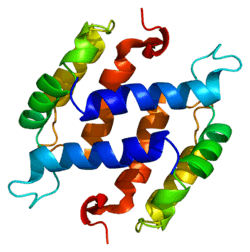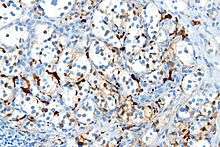S100 protein
| S100/ICaBP type calcium binding domain | |||||||||
|---|---|---|---|---|---|---|---|---|---|
 Structure of the S100B protein. Based on PyMOL rendering of PDB 1b4c. | |||||||||
| Identifiers | |||||||||
| Symbol | S_100 | ||||||||
| Pfam | PF01023 | ||||||||
| InterPro | IPR013787 | ||||||||
| PROSITE | PDOC00275 | ||||||||
| SCOP | 1cnp | ||||||||
| SUPERFAMILY | 1cnp | ||||||||
| |||||||||
The S100 proteins are a family of low-molecular-weight proteins found in vertebrates and characterized by two calcium-binding sites that have helix-loop-helix ("EF-hand type") conformation. There are at least 21 different S100 proteins.[1] They are encoded by a family of genes whose symbols use the S100 prefix, for example, S100A1, S100A2, S100A3. They are also considered as Damage-associated molecular pattern molecules (DAMPs) and knockdown of AHR downregulates the expression of S100 proteins in THP-1 cells.[2]
Structure
Most S100 proteins are homodimeric, consisting of two identical polypeptides, which are held together by non-covalent bonds. S100 proteins are structurally similar to calmodulin. On the other hand, they differ from calmodulin on the other features. For instance, their expression pattern is cell-specific, i.e. they are expressed in particular cell types. Their expression depends on environmental factors. To contrast, calmodulin is a ubiquitous and universal intracellular Ca2+ receptor widely expressed in many cells.
Normal function
S100 proteins are normally present in cells derived from the neural crest (Schwann cells, and melanocytes), chondrocytes, adipocytes, myoepithelial cells, macrophages, Langerhans cells,[3][4] dendritic cells,[5] and keratinocytes. It may be present in some breast epithelial cells.
S100 proteins have been implicated in a variety of intracellular and extracellular functions.[6] S100 proteins are involved in regulation of protein phosphorylation, transcription factors, Ca2+ homeostasis, the dynamics of cytoskeleton constituents, enzyme activities, cell growth and differentiation, and the inflammatory response. S100A7 (psoriasin) and S100A15 have been found to act as cytokines in inflammation, particularly in autoimmune skin conditions such as psoriasis.[7]
Pathology

Several members of the S100 protein family are useful as markers for certain tumors and epidermal differentiation. It can be found in melanomas,[8] 100% of schwannomas, 100% of neurofibromas (weaker than schwannomas), 50% of malignant peripheral nerve sheath tumors (may be weak and/or focal), paraganglioma stromal cells, histiocytoma and clear cell sarcomas. Further, S100 proteins are markers for inflammatory diseases and can mediate inflammation and act as antimicrobials.[9]
S100 proteins have been used in the lab as cell markers for anatomic pathology.
Human genes
- S100A1, S100A2, S100A3, S100A4, S100A5, S100A6, S100A7 (psoriasin), S100A8 (calgranulin A), S100A9 (calgranulin B), S100A10, S100A11, S100A12 (calgranulin C), S100A13, S100A14, S100A15 (koebnerisin), S100A16
- S100B
- S100P[10][11]
- S100Z (S100Z)
CRNN; FLG; FLG2; HRNR; RPTN; S100G; TCHH; THHL1;
Nomenclature
The "S100" symbol prefix is derived from the fact that these proteins are soluble in 100%, i.e. saturated, ammonium sulfate at neutral pH. The symbol has often been hyphenated,[12] but current gene and protein nomenclature, such as HGNC nomenclature, does not use hyphens in symbols.
See also
References
- ↑ Marenholz I, Heizmann CW, Fritz G (2004). "S100 proteins in mouse and man: from evolution to function and pathology (including an update of the nomenclature)". Biochemical and Biophysical Research Communications. 322 (4): 1111–22. doi:10.1016/j.bbrc.2004.07.096. PMID 15336958.
- ↑ Memari B, Bouttier M, Dimitrov V, Ouellette M, Behr MA, Fritz JH, White JH (2015). "Engagement of the Aryl Hydrocarbon Receptor in Mycobacterium tuberculosis-Infected Macrophages Has Pleiotropic Effects on Innate Immune Signaling". Journal of Immunology. 195 (9): 4479–91. doi:10.4049/jimmunol.1501141. PMID 26416282.
- ↑ Wilson, AJ; Maddox, PH; Jenkins, D (January 1991). "CD1a and S100 antigen expression in skin Langerhans cells in patients with breast cancer.". The Journal of pathology. 163 (1): 25–30. doi:10.1002/path.1711630106. PMID 2002421.
- ↑ Coppola D, Fu L, Nicosia SV, Kounelis S, Jones M (1998). "Prognostic significance of p53, bcl-2, vimentin, and S100 protein-positive Langerhans cells in endometrial carcinoma". Human Pathology. 29 (5): 455–62. doi:10.1016/s0046-8177(98)90060-0. PMID 9596268.
- ↑ Shinzato M, Shamoto M, Hosokawa S, Kaneko C, Osada A, Shimizu M, Yoshida A (1995). "Differentiation of Langerhans cells from interdigitating cells using CD1a and S-100 protein antibodies". Biotechnic & Histochemistry. 70 (3): 114–8. doi:10.3109/10520299509108327. PMID 7548432.
- ↑ Donato R (2003). "Intracellular and extracellular roles of S100 proteins". Microscopy Research and Technique. 60 (6): 540–51. doi:10.1002/jemt.10296. PMID 12645002.
- ↑ Wolf R, Howard OM, Dong HF, Voscopoulos C, Boeshans K, Winston J, Divi R, Gunsior M, Goldsmith P, Ahvazi B, Chavakis T, Oppenheim JJ, Yuspa SH (2008). "Chemotactic activity of S100A7 (Psoriasin) is mediated by the receptor for advanced glycation end products and potentiates inflammation with highly homologous but functionally distinct S100A15". Journal of Immunology. 181 (2): 1499–506. doi:10.4049/jimmunol.181.2.1499. PMC 2435511
 . PMID 18606705.
. PMID 18606705. - ↑ Nonaka D, Chiriboga L, Rubin BP (2008). "Differential expression of S100 protein subtypes in malignant melanoma, and benign and malignant peripheral nerve sheath tumors". Journal of Cutaneous Pathology. 35 (11): 1014–9. doi:10.1111/j.1600-0560.2007.00953.x. PMID 18547346.
- ↑ Wolf R, Ruzicka T, Yuspa SH (July 2010). "Novel S100A7 (psoriasin)/S100A15 (koebnerisin) subfamily: highly homologous but distinct in regulation and function". Amino Acids. 41 (4): 789–96. doi:10.1007/s00726-010-0666-4. PMID 20596736.
- ↑ Penumutchu, Srinivasa R.; Chou, Ruey-Hwang; Yu, Chin (2014-08-01). "Structural Insights into Calcium-Bound S100P and the V Domain of the RAGE Complex". PLOS ONE. 9 (8): e103947. doi:10.1371/journal.pone.0103947. ISSN 1932-6203. PMC 4118983
 . PMID 25084534.
. PMID 25084534. - ↑ Penumutchu, Srinivasa R.; Chou, Ruey-Hwang; Yu, Chin (2014-10-17). "Interaction between S100P and the anti-allergy drug cromolyn". Biochemical and Biophysical Research Communications. 454 (3): 404–409. doi:10.1016/j.bbrc.2014.10.048. ISSN 1090-2104. PMID 25450399.
- ↑ Elsevier, Dorland's Illustrated Medical Dictionary, Elsevier.
Further reading
- Wolf R, Voscopoulos CJ, FitzGerald PC, Goldsmith P, Cataisson C, Gunsior M, Walz M, Ruzicka T, Yuspa SH (2006). "The mouse S100A15 ortholog parallels genomic organization, structure, gene expression, and protein-processing pattern of the human S100A7/A15 subfamily during epidermal maturation". The Journal of Investigative Dermatology. 126 (7): 1600–8. doi:10.1038/sj.jid.5700210. PMID 16528363.
- Wolf R, Howard OM, Dong HF, Voscopoulos C, Boeshans K, Winston J, Divi R, Gunsior M, Goldsmith P, Ahvazi B, Chavakis T, Oppenheim JJ, Yuspa SH (2008). "Chemotactic activity of S100A7 (Psoriasin) is mediated by the receptor for advanced glycation end products and potentiates inflammation with highly homologous but functionally distinct S100A15". Journal of Immunology. 181 (2): 1499–506. doi:10.4049/jimmunol.181.2.1499. PMC 2435511
 . PMID 18606705.
. PMID 18606705. - Wolf R, Voscopoulos C, Winston J, Dharamsi A, Goldsmith P, Gunsior M, Vonderhaar BK, Olson M, Watson PH, Yuspa SH (2009). "Highly homologous hS100A15 and hS100A7 proteins are distinctly expressed in normal breast tissue and breast cancer". Cancer Letters. 277 (1): 101–7. doi:10.1016/j.canlet.2008.11.032. PMC 2680177
 . PMID 19136201.
. PMID 19136201. - Wolf R, Mascia F, Dharamsi A, Howard OM, Cataisson C, Bliskovski V, Winston J, Feigenbaum L, Lichti U, Ruzicka T, Chavakis T, Yuspa SH (2010). "Gene from a psoriasis susceptibility locus primes the skin for inflammation". Science Translational Medicine. 2 (61): 61ra90. doi:10.1126/scitranslmed.3001108. PMID 21148126.
External links
- S100 Proteins at the US National Library of Medicine Medical Subject Headings (MeSH)